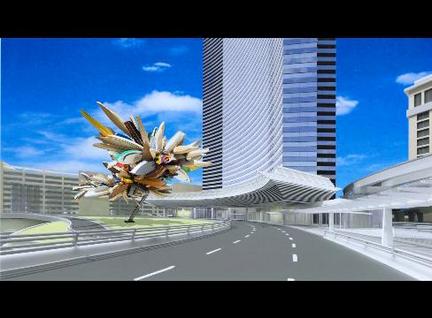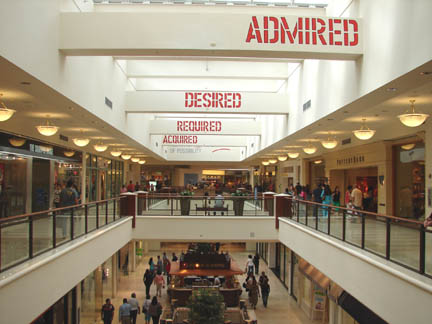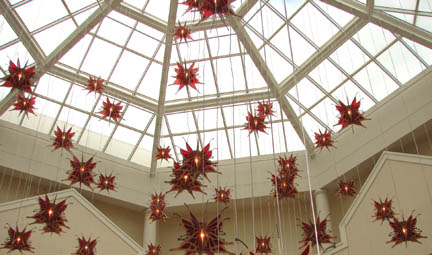Recently in main Category
How to think about public art? Do you just keep doing the same thing? Big art? Architectural intimacy? Site-specific narrative? Locally responsive?
Internationally, public art has been institutionalized as the founder's dreamed in the 1960 and 1970s. Big - intimate - narrative - responsive. Most importantly, appreciated by a small, but growing group, and accepted by most. Richard Serra's "Tilted Arc" would NEVER be removed today.
What was not anticipated was 1.) public art as a defined field separate from museum art and 2.) global uniformity. They could not have imagined 1.) daily Internet access to any public artwork and 2.) participation in public art through cell phones and Internet.
What has not materialized in the USA is 1.) respect for the individual artistic career and 2.) pride (or tolerance) in a culture that sponsors artworks of political and social content. Respect continues to expand for artists in the corporate or spectacular arts - movies, music videos, concerts, advertising, fireworks, theme parks, architecture (and some urban space or landscapes). For time being, the Internet provides the public venue for creative public works in politics and social observation.
Perhaps, the Internet removes the psychological need for public political expression in physical public art (except when used as a method to gain access to broader media channels and new audiences). At a recent dialogue at the New Museum in NYC with street artists selected by the Wooster Collective, politics had almost no role in the content of the art. These street artists personalized the generic elements of urban places such as billboards, light poles and road markings. Individualizing and manipulating the institutional forms has a political dimension as an act where acts by individuals are prohibited, but abandons public space as a canvas for unique commentary on culture.
As I try to come back to discourse - a mental activity removed from professional public art administration - I have been reading about "Relational Aesthetics". Although this theory that has inspired many public works of interaction among particular publics, Relational Aesthetics confirms the tiny, insignificant role of visual art by removing any cultural objectives beyond a knitting function for different groups and ideas. Any goals of global transformation are abandoned as 20th century failures. The dreams expressed as utopia have no value. Just make the best of the circumstances.
In general, theory is mainly the emphasis of one part of the same reality. "Making the best of circumstances" was an important element of any revolutionary act. In the 20th century, the objectives reigned supreme. Now the circumstances have the public relations edge, but art is still a singular act to make something that will change or reinforce human knowledge, values and future acts.
Revolution is a communal act in which art was a symbol and an example - not the motivation. A minority of artists - open to change and desiring notoriety - were frequently with the vanguard. In this world without hope in communal acts, Relational Aesthetics and contemporary public art practice makes sense as the symbol and an example. Make the best of circumstances with a clever mind, sensitive heart and functional results. Leave the best of all possible worlds to another generation.
Well that did not answer anything about public art. Except to say that the best public art in our time would be big, intimate, narrative and responsive with a functional justification and produced by an artist(s) with a clever mind and sensitive heart.
A lot of examination of public art this week (Sept 7-Sept 14, 2008). Get online or a subway car.
- Giant mechanical spider roams the streets of Liverpool, UK. Produced by Royal de Luxe, Artichoke and/or La Machine that produced the "Sultan's Elephant" in London in 2006.
- Dozens of small scale, site-specific interventions through out New York City via the Conflux Festival
- Blast Theory's new virtual/real space game can be played on-line in the morning on Friday, Saturday or Sunday (EST) (Click here to play) or at Royal Opera House in London for the Deloitte Ignite festival.
- Bronx Museum of the Arts opens the "Street Art" exhibition documenting a selection of performance or action driven outdoor artworks since the 1950s. Street festival on Sunday afternoon.
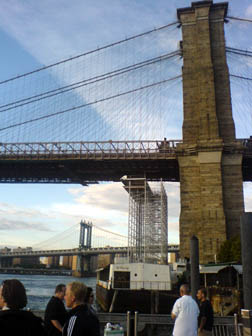
MOMA and PS1 prepare the public for the "Watersfalls" later this month in NYC. The the scaffolding has been constructed under the Brooklyn bridge. Photo taken on May 26.
From the Bay Area and Boston emerge artworks that are mainly science projects overlaid with pretty colors so they can be called "art". The interaction is fun for ten minutes and we like to take new visitors as they will marvel. We fake enthusiasm based on a memory our our first time so that we can truly enjoy their reaction. But the work fails to provide any personal thrill again. And for all the statements by the artists and curators, no significant thought comes to mind at all - except the terror of the possible future.
Olafur Eliasson moves between public science project and public art. Many are science tricks directed toward internal artworld reflections. A moving colorfield painting in light, the live black&white 3-D movie or the invisible white gallery box inside the white gallery box. Some are little silly like the reverse cascading waterfall where he sprays the water up from one pool to the next.
The genius of Eliasson emits from his stubborn battle with the photographic record: still or moving. He seeks to make works that can only be completely appreciated through "being-in" the artwork. (I have written about "being-in" regarding the architecture in the northwest USA - a place grounded in Scandinavian culture like Eliasson). Yet, many of Eliasson's best installations "The Weather Project" at the Tate Modern in London and the 360 Degree Room of All Colours at MOMA generate "artistic" amateur photos in the same way as Gromley's work. His is a battle, not a rejection.
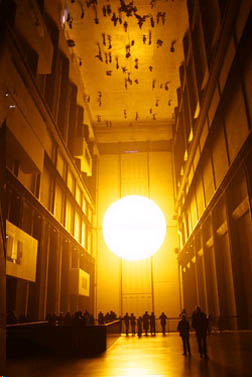
Anything claiming to be art requires the in-person experience to be fully appreciated. If you see a documentary picture or video of an artwork and think the artwork will be the same in person, then in my book you have a problem. (Of course the LCD monitor or paper magazine can be the intended home of the art.) The amateur photographs of The Weather Project make me want to be there. Through the photos, I have a sense, true or not, that the experience would be romantic and enveloping. Gromley's work makes me want to compete in the undeclared photo taking contest, not necessarily to be in the space. Eliasson's photos make me dream of the visit.
Two of the works at MOMA are brilliant and the "Take Your Time" room at PS1 exceeds any carnival fun-house of mirror rooms and tricks. Completely ignored by nearly all visitors, beige moss - of a type used for architectural models - densely covers each inch of the large gallery wall. Moss Wall is a visual trip over the Amazon Rain forest. Only by viewing the work from 6-10 inches can it unfold. As that visual range, the human eye and brain together imagine "depth of field" and a complete 3D visual experience that become physical. The human brain feels the tiny changes in elevation as you move your head and eyes like an airplane plane. But at 200 or 300 feet above a real forest, the eyes and brain do not feel any 3D effect. Eliasson discovered that multidimensional physical reactions can be sparked in the body.
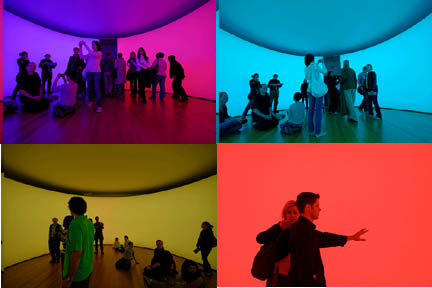
360 Degree Room of All Colours turns color into music. The circular space changes its pastel colors in slow repetition. The light level is PERFECT for the human eye in that pupil is fully open without the need to squint. If you stare into the fabric walls from 10 inches, your entire field of vision fills with one color. Only on a sail-less boat in the sea with a low sun, can you stare at the dome of the sky with a similar full view of blue. I loved it, but this is not the surprising part. If you sit of floor and a stare, the color change from washed out to very intensive pastel. My body started to feel the motion of the colors in ways that can only be compared to music. The chemical levels in my body shot up with the swelling of the color intensity.
Since architecture school, I had been told of psychological power of color, but never the physiological. Still part science, but like other chemicals in the body, I am hooked and looking for my next dose.
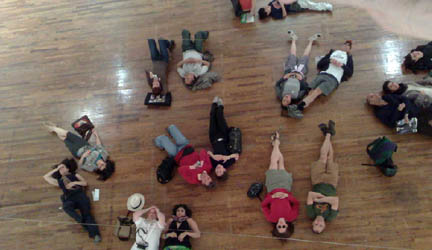
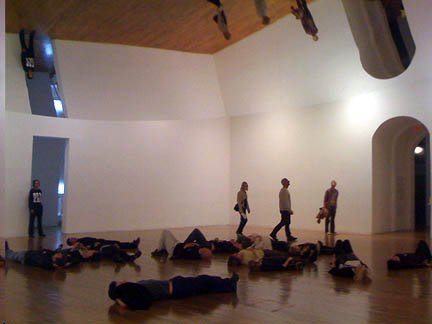
Finally, Take Your Time at PS1. A huge disc cover red in reflective mylar rotates very slow on the ceiling. Immediately, everyone dives to floor and looks up. Your brain tells you that all the people - including yourself - are not lying on the floor, but suspended magically on a vertical wall with less effort that Spiderman. That is the fun house trick. The questions is - why do you want to lay there for minutes and minutes? People don't want to leave.
The mirror is tilted about 3%. Patience and 3% is the genius of the work. The angle causes the reflection of the visitors and the walls of the room to change very, very slightly in a loop. Again, somehow and for some reason, the brain knows that the view is changing and therefore remains alerts and interested. Unless you move the very edge of the disk, you can get yourself to consciously recognise the change. Like the colors in the 360 Degree Room, you body responds - in this case the brain - without consciousness.
Perhaps Eliasson has invented the first of science of art since gestalt.
I don't know how other creative people can utilize Eliasson's operational observations, but the work drives home the memory of special sunsets and hours napping adjacent to a waterfall in the forest. He proves that humans can make the spaces that facilitate these calm and happy moments. Thank you Mr. Eliasson.
Thank you for the Images
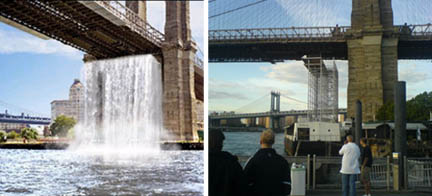
The Waterfalls produced by the Public Art Fund. Opening soon.
Returning to New York City after a 20-year journey in Seattle and South Florida. New York taught me how to think art.
Psychologically, NYC has changed dramatically. Signs in the subway remind parents to keep baby carriages off the escalator. Street territory has been reapportioned for small plazas to hangout or walk more comfortably. Only a few of the former down-and-out residents of the street remain. The permanent abandonment of former brick tenements has ceased. Dark windows signal the wrecking ball and renewal, not the hopelessness.
Of course, the dark hopeless territories still exist, but many, many people can live and work in Manhattan rarely encounter the misery. In the 1980s when I organized artistic critiques of the civic abandonment, all peoples in Manhattan had to divert their hearts away from the people of the streets or the five stories of broken glass. We artists were saddened and angry at the diversion- but that anger sparked thought, energy and action through art or body or both.
On Wednesday, I revisited one of the most dangerous Manhattan zones in the 1980s - the meatpacking district. Today, the pristine storefronts are so numerous and trendy that both Samantha and Carrie from "Sex in the City" shopped there. I thought I was walking in some kind of strange dream where the fairy godmother swooped her wand and sparkled the filth into beautiful clothes for everyone.
One art gallery, Leo Keating Gallery, had sponsored an art event to raise money for the new Highline park that will open in a few months. The use of the old elevated rail tracks was a favorite student architecture project in the 80s and 90s. One of architect Steven Holl's very early theoretical projects proposed housing on the tracks. Now after ten years of advocacy and fund raising, the Highline will become a public park - an important part of the literal greening of Manhattan.
To raise cash, the gallery was selling fluorescent green chalk shoes by Julia Mandle. Earlier in the month, she put shoes on various students from nearby schools and they drew a path on the sidewalk to the Highline. A simple idea to tell the children, their friends and their parents that the Highline was coming to the neighborhood. On the night of the gallery opening, she and a friend where making an apparently arbitrary path through the new glamour of the meat packing district. Following the path that evening would lead you to the gallery or to her on the shoes.
The gallery did not have significant posters about the Highline and the artist was not carrying any information with her. This absence of information is a very New York thing that does not happen in other parts of the USA. As I remember from days past, the New York art world believes that explanation apparently degrades the artwork. Converting the thing from art to advertising. 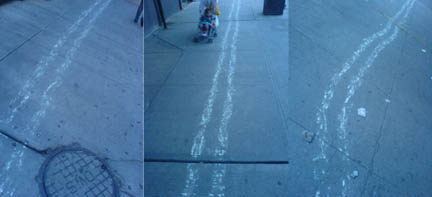
My new paying job is to create a consistent public art program for the Times Square Alliance. Advertising, not art, dominates Times Square. So my new work takes me straight to conflict between the instinct for ambiguous poetic connotations of art and the directive for the clear targets of advertising. 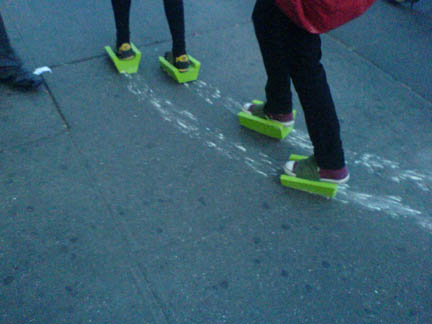
Yet the visitors to Times Square desire the unexpected. The protective judgments about art back home are abandoned in Times Square and the energy of strangeness is embraced. Instead of secrecy of naughty personal acts in the Vegas slogan "What happens here, stays here", a visit to Times Square might generate a celebratory slogan like "Look what happened to me here". The visitors snap pictures of every new billboard and ask a friend to record their strange encounters with Naked Cowboy or the two Statues of Liberty that graced Times Square today with a background of Peruvian flutes. What better place could exist for public art to receive the full acceptance of all types of folks?
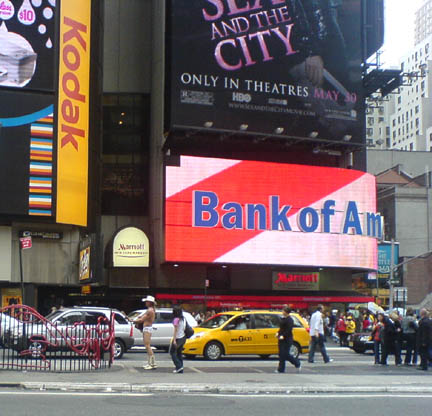
On April 11 in North Carolina, Glenn Harper, Editor of Sculpture Magazine and Bill Thompson, Editor of Landscape Architecture, and I meet to kick off the "Public Art 360" Conference. Click Here to Attend. In the next few weeks, I will publish some of my letters to Harper and Thompson in preparation for the dialogue.
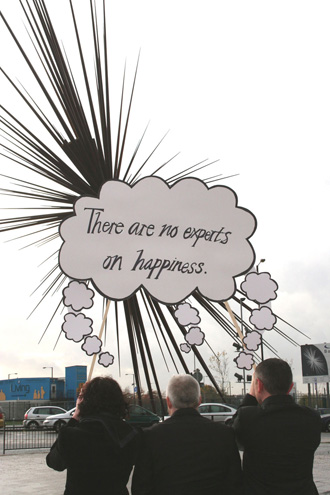
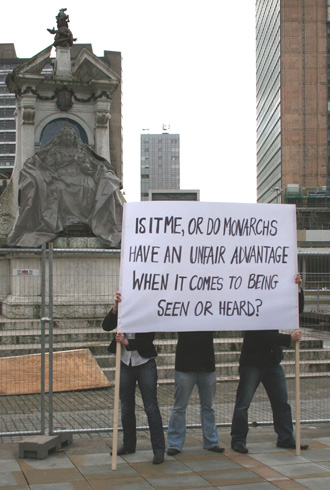
LATE ADDITION
SEE GOOD COMMENTARY BY RIES IN THE COMMENTS.
Subscribe to Aesthetic Grounds Bi-Weekly Summary:
Digg it...Del.icio.us ...Technorati...Stumble Upon..Reddit
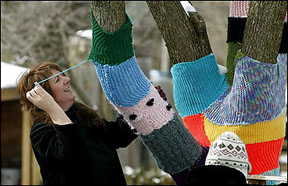 At the end of last week, two public art projects competed for media attention in the USA. In the small town of Yellow Springs, Ohio, a few local women knitted a sweater for ONE tree during a winter day. Any volunteer knitter could climb the eight-foot ladder and add her wrap to the tree trunk or limb. In Las Vegas, two of world's largest resort and gaming corporations announced a $40 million dollar expenditure for fine art at the future CityCenter $8 billion casino and resort. New huge artworks have been commissioned from Jenny Holzer, Nancy Rubins, Maya Lin and Richard Long plus the display of large existing works by Oldenburg/ van Bruggen, Frank Stella and Henry Moore.
At the end of last week, two public art projects competed for media attention in the USA. In the small town of Yellow Springs, Ohio, a few local women knitted a sweater for ONE tree during a winter day. Any volunteer knitter could climb the eight-foot ladder and add her wrap to the tree trunk or limb. In Las Vegas, two of world's largest resort and gaming corporations announced a $40 million dollar expenditure for fine art at the future CityCenter $8 billion casino and resort. New huge artworks have been commissioned from Jenny Holzer, Nancy Rubins, Maya Lin and Richard Long plus the display of large existing works by Oldenburg/ van Bruggen, Frank Stella and Henry Moore.
Here is the result of "Head to Head" public art media blitz.
Yellow Springs Knitters
·
Strategy: Someone must have known a local AP stringer. Stringer pitches story to AP. Report with picture hits the AP wire.·
Results: Multiple publications in daily newspapers across the United States including Washington Post, NY Times, Boston Globe, International Herald Tribune, etc, etc, etc.·
Economic Development: Yellow Springs spreads its reputation as an "artsy" community.MGM Mirage and Dubai World
·
Strategy: Write the article in the form of a press release and distribute via prnewswire.com. Call up editors and reports at various papers. Push hard.·
Results: One print article outside Nevada in the NY Times with online slide show that was picked up and republished in Taipei. Partial or full posting of prnewswire text on online business or gaming websites.·
Economic Development: Las Vegas has upscale resorts equivilent to Dubai.
Nancy Rubin Proposal for CityCenter
I am interested in why the Yellow Springs knitters out paced MGM Mirage. The greater success Yellow Springs comes from the actual installation of the artwork, not just a story about the future. Real people and their honest reactions could be interviewed on the streets near the tree. The NY Times had to stretch to find a few quotes and a very staged picture of Ms. Lin with a tiny segment of her silver river.
Yellow Springs had other advantages that public art programs might note. The artwork was colorful and clearly understood by a single photograph - strips of knit fabric tightly wrapping the trunk and limbs by local women as a celebration of winter and their own joyful spirit. The visual effect was dynamic on the tree.
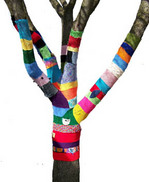 As reported by AP, Corrine Bayraktaroglu, an artist who helped start the "knitknot tree" project, stated: "People are really, really enjoying it. They're coming from towns to have their photograph taken with the tree."
As reported by AP, Corrine Bayraktaroglu, an artist who helped start the "knitknot tree" project, stated: "People are really, really enjoying it. They're coming from towns to have their photograph taken with the tree."
How many civic art programs strive for this reported comment on an abstract, design-integrated public artwork: "It looks like Yellow Springs; it's unique, it's colorful, unpredictable," said Lynda Sirk. "It makes me smile. That's what I like." Unique, colorful, unpredictable - all words welcome in any critical commentary on Nancy Rubins, Frank Stella and Oldenburg/van Bruggen in Las Vegas.
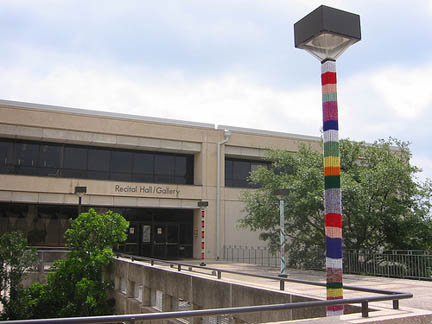
Houston's Knitta wrapping light poles in San Antonio
I was surprised to learn that knitted artworks for the street are a practiced artform. A group of six artists from Houston called Knitta have been collectively wrapping elements of the street for the last three years. A knittaplease photo collection is available on Flickr.
Tree Cozies in Indiana (photos "The Republic")
Also this winter is the tree cozy competition in Columbus, Indiana. 30 artists wrapped the lower trunk of 30 street trees with knitted works. Alice Dorwsky (spelling help?) of New England has been making beautiful yellow wraps and tree hangings for the last few years.
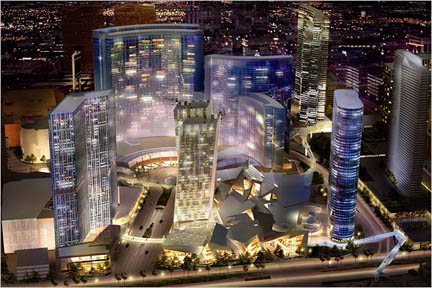
CityCenter Design (NY Times Slide Show)
Back to CityCenter in Las Vegas. What to make of the end of bad taste in Sin City? When Steve Wynn added art to his other casinos in the 1990s, the art was tasteful, but not the setting. With CityCenter line up of architects - Foster, Pelli, Vinoly and Libeskind - now the French and other European critics will stop commenting and Japanese youth will stop visiting. Viva Las Vegas might be approaching retirement. Even Las Vegas can become just another flashy resort. What could be worse?
For the record, $40 million is only one-half of a percent (1/2%) of the $8 billion project. So although it sounds and IS a lot of money for art, a typical 1% for art program would receive $80 million.
But still the world was more interested in the $50 dollars of yarn in Yellow Springs this weekend.
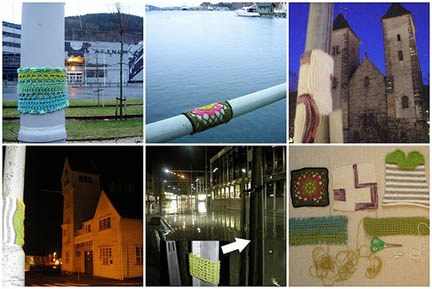
Twice I read Derek Merrill & Beau B. Beza's essay in Refractory: a Journal of Entertainment Media. The writers utilize the concept of the "screen" to explore Atlantic Station development in Atlanta, Georgia. Atlantic Station is a environmental urban brownfield redevelopment and reclamation of the 100-year-old Atlantic Steel Mill requiring the removal of 9,000 dump truck loads of contaminated soil. The 138-acres are divided into three zone: mixed use outdoor shopping mall with 6 million SF of office highrise space, mid-rise apartments surrounding a wetland and the IKEA store. Due to the terrain and earth removal, all the public parking is below ground providing much more flexibility in pedestrian space design.
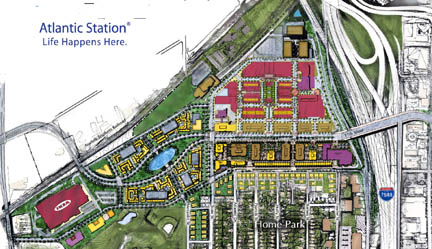
I wrote Merrill and Beza that the screen was a poor choice of words to assist with the analysis. It was a forced metaphor regarding the spatial conception. I visit as many new urbanist places as possible to understand them. The designers conceive these developments as a series of territorial types, which are set next to each other. Each territory has an aesthetic heart (round, linear or grid) that is defined with building facades.
Once leaving the hearts, transitions between territories are very awkward and rely on the road to rudely connect them. The locations of the screens are the empty car zones of garages, parking lots, alleys or highways. The resident and visitor are supposed to mentally ignore these places like the toilet in the mansion. The leftover space is just that.
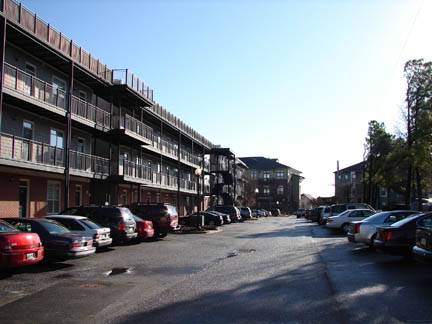
Harbor Town leftover space. (Frequently praised as multi-use parking)
The key to the spatial failure is the unrelenting demand for tiny heart after tiny heart. Each territory is not provided enough space to establish the vernacular repetition and controlled variation that we understand as a neighborhood or city. Without enough territory for natural repetition, control will be the psychological sense of the place. And control is the generator of discomfort for the some and the source of security for others. For many bloggers - extreme discomfort.
The irony is that the tiny hearts or odd spaces of containment are the moments we seek and remember in the suburban or low-scale urban environments. Somehow when designed, the feeling is control and not joy. The joy arises from the efforts of single person with a little imagination or a failure of coordination in the overall design.
When examining new urbanism, I must always remember that it is a developer's alternative to the gated suburban apartment complex and single-family neighborhood. New urbanism should be judged against the other choice for newness - not the neighborhoods with centuries or decades of demolition and remodeling. Eventually these places will be personalized and the control may dissipate. Or like the highly controlled of designs of late 19th and early 20th century religious retreats or military bases, the control will seem benign and part of another era. The museum viewing or resort dwelling instincts will take hold and replace the judgment standards of neighborhood living.
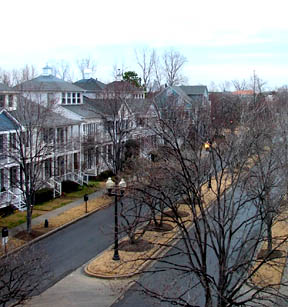
Recently, I visited Memphis and had the opportunity to spend a couple nights in the River Inn in Harbor Town. Harbor Town is one of the older new urbanist developments in the USA with the first sales in 1991. The mature landscape and some personalization have already emerged. The commercial mixed-use area has a messiness with different building types and scales that humanizes the space. It appears the architects - Loney Ricks Kiss - where designing by accommodation that than preconception. The personalization arises when the overall structure fails to resolve the space and the individual architects, gardens and owners must find a solution. Harbor Town proves the new urbanist system can succeed without the stylistic and spatial tyranny.
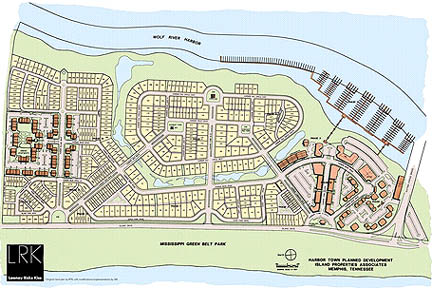
Harbor Town site plan on the Mississippi River by LRK.
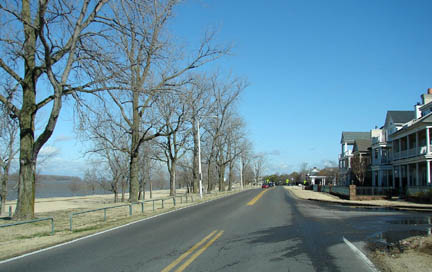
Front onto the Mississippi River
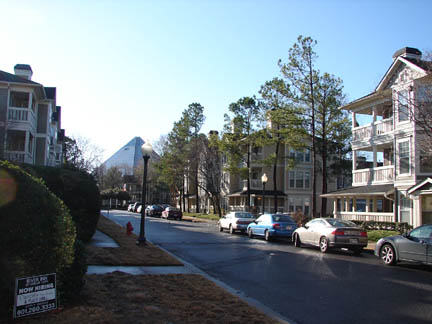
Harbor Town mature trees (Note the Memphis pyramid)
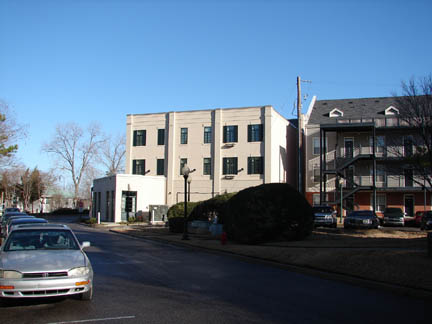
Harbor Town with a little age and inconsistency
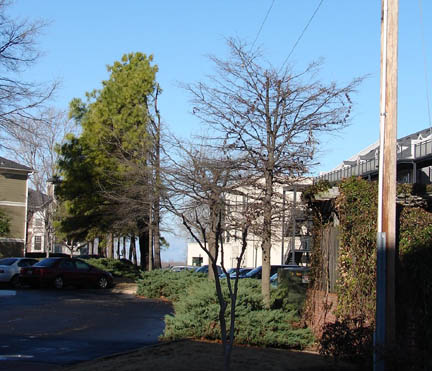
The imperfections start to emerge after 15 years.
Digg it...Del.icio.us ...Technorati...Stumble Upon..Reddit
NEW ORLEANS
"Next American City" Explores New Orleans
Free
SYMPOSIUM:Sparking Creativity: Investing in Entrepreneurship and Human Capital Post-Katrina,
Thursday, March 6, 2008, 6-8 pm
A small business is not just a building. It's an investment in a person who is willing to invest back into their community. As post-Katrina New Orleans struggles to rebuild itself, we ask the question, What is there to invest when there is nothing to provide to a community. More importantly, what is there to provide when there is no community?
Saturday, March 8, 2008
On the Ground for 24 Hours in New Orleans. Join the Next American City staff and friends for a 24 exploration of New Orleans. Meet the group at Jackson Square in the French Quarter, across from the St. Louis Cathedral at 11a.m. on Saturday. (As on March 4, the Brad Pitt's pink house project has 79 sponsors of new houses. Still 71 to go to 150 homes in the ninth ward. )
Check out the documentation on the Philly 24 Hours as a sample of the New Orleans tour.
ATLANTA
Public Art Resource Expo, Free
Museum of Contemporary Art, Atlanta, GA
March 15, 2008, 10:00-4:00
A networking day for artists, private developers, architects, civic leaders and the general public to learn about public art and to discover available opportunities, services, vendors, and resources. Free admission. For more information: dmcduggie@atlantaga.gov
BOSTON
Sustainable Design: At the Crossroads of Art, Policy and Science
Hynes Convention Center, Boston
March 29, 2008 at 1:00 PM
Free
A joint program of the UrbanArts Institute at Massachusetts College of Art and Design, Goethe-Institut Boston and Down:2:Earth (D2E), a sustainable living expo at the Hynes Convention Center. The panelists will explore sustainable design in the context of art, science and policy and showcase environmentally responsible products and places. Go see Singer if you have not heard him speak. The others appear more product oriented, but "green" is still a hands-on "garage" business. Before the corporations take over, enjoy the final days of invention by real people.
Michael Singer, Artist/Designer
Ursula Tischner, Cologne, Germany
Teresita Cochran of Smit Design
Moderated by Terry Swack, Founder/CEO, Clean Culture
NORTH CAROLINA
Public Art Symposium: Public Art 360
Chapel Hill, North Carolina
Friday evening April 11 and all day Saturday April 12, 2008
$60.00
A symposium that goes beyond education on public art. The symposium has the potential to spark some valuable dialogue that might be carried onto Philadelphia and Grand Rapids later. When Janet Kagan asked me to speak, I said I would pay my own way if she could get the editors of Sculpture Magazine and Landscape Architecture on the stage talking about the public art. She did it. If you fly to one educational event in 2008, this could be the one. Fly into Greensboro, Charlotte or Raleigh airports and drive through the dogwoods to the University of North Carolina. North Carolina is pretty and smart. www.publicartcollaborative.org
Friday Night, April 11
Glenn Harper, Editor of Sculpture Magazine
Bill Thompson FASLA, Editor of Landscape Architecture
Glenn Weiss, Aesthetic Grounds of Arts Journal
Just a few on Saturday, April 12
Janet Eshelman, Artist of the giant net coming to Phoenix
Brett Cook, Artist of Community Building
Walter Hood, Landscape Architect / Public Artist
Robert Frasca, Architect supporting Public Art
Sarah Herda, Graham Foundation and Formerly at the Storefront
SOUTHERN CALIFORNIA
The First Desert Cities Public Art Forum: "Facing Public Art Challenges and Finding Solutions"
Palm Desert, California
Public Art Professionals Day with Jessica Cusick, Public Art Manager, Santa Monica
Friday, April 4, 2008, 9:30 to 3:00 PM
Public Artists' Day with Cliff Garten, Artist
Saturday, April 19, 2008, 9:30 to 3:00 PM
Free but must register by March 20th, 2008
BOSTON
8th Annual Systems for Inclusion
Harvard University, Graduate School of Design, Cambridge, MA
Friday, April 4th at 6:00 PM to Sunday, April 5th at Noon.
$35 to $150 for income different groups
Systems for Inclusion explores the interface of design and systemic social action: Can design(ers) challenge globally networked systems of exclusivity and inequality? What are the relationships between design and political power, economic and ecological sustainability, justice and community? 8th year organized by the Design Corps. Excellent line up of designers discussing the AVOIDED in design dialogue: social sustainability, community design, political art, political power, etc. The great Japanese architect Shigeru Ban speaks on Friday night.
WESTERN MASSACHUSETTS
Symposium: Art in the Public Sphere: Singular Works, Plural Possibilities
University Gallery, University of Massachusetts, Amherst, MA
Friday, April 25, 2008 from 9:30 am to 4:30 pm
Free
A day long series of conversations and panel discussions with uMass scholars and internationally known experts such as Vito Acconci and George Trakas, public art curators Ann Pasternak (director of Creative Time) and Rick Lowe (artist and founder of Project Row Houses in Houston); will provide a critical forum to consider various theories, processes, and models for artistic intervention. Symposium.
FLORIDA
Annual Conference of Florida Public Art Administrators
Orlando, Florida
May 7 - 9, 2008
$150
For ten years, the public art administrators have been gathering in a Florida city to discuss common issues and the tour the local artworks. Well-organized and informal. Guest administrators welcome.
PHILADELPHIA
Americans for the Arts Conference, Public Art Track
June 19-22, 2008
$500 for all days or $275 for one day.
This is the networking and learning event for public art in the United States. The conference is pricey since the 1 ½ day special public art pre-conference was merged with the big conference for all the arts. For those of you with less cash or time, pay the one-day fee and come for all day Sunday, June 22nd. The best projects in the USA are visually presented at noon. Several potentially good panels from artists, critics and curators. I am praying that the last panel on Sunday - Public Art: The Next Generation will have something crucial and critical to yell. Sunday ends with a gathering at the Philadelphia Museum of Art - always a pleasure. Parties at local public artist studios are rumored for Saturday night. Complete schedule at Public Art Track and at Public Art Panels.
Digg it...Del.icio.us ...Technorati...Stumble Upon..Reddit
Imagine an argument about the value of surprising public art and well-designed public space.
Interesting that I feel the need to add "well-designed" to public space. Public space ALWAYS exists so it MUST BE qualified. Public art is always an optional ADDITION and very, very rare when compared to the quantity of public space. [Perhaps I am wrong and the value of the gigantic ether of nearly invisible public space needs consideration. Many observers note the reduction in public space by "corporate interests" with the loss of the democratization of any and all publicly accessible space that was gained in 20th century. Not really less space, but a transformation of "id" space into "super-ego" space.]
I choose "surprising" because all good artworks must reach beyond my expectations on every real viewing. The work and its site must have the ability drag me back to look, to feel and to think again. A surprise that demands as much work from me as the object or space.
Satisfaction of the anticipated is not enough, but is generally the highest achievement of government projects of all types. The successful risk takers in government administration raise the level of the anticipation. This is a tricky business. The risk taker must convince others in power that the public's level can also be raised and then satisfied. I once witness the director of the Seattle Public Library raise the level such that only architect Rem Koolhaas could satisfy the level. Brilliant.
We are seeing this in the Democratic primary where Obama has successfully raised anticipation for a "people-serving government" and Clinton has called into question his ability to achieve the result. As per all questions in government (public art and public space), the voters are choosing between guaranteed lower level achievement and a hope for a higher level.
The definition of well-designed might be the satisfaction of the anticipated. As government public art programs age, "well-designed" becomes a popular adjective. We desperately need to renew the surprise in public art.
Digg it...Del.icio.us ...Technorati...Stumble Upon..Reddit
Not to reveal too much, but I typed "public art" into the job search site, Indeed. The public art field and civic leaders have under-estimated the role of public art in job recruitment, especially among doctors and nurses. Many medical recruiters highlight the excellent quality of a city's pedestrian environment by listing public art. I wonder if the Creative Cities researchers have linked up this data.
Perhaps the recruitment is it part due to years of artworks in hospitals. As city and county art programs receive most of the credit for public art, hospitals and medical centers have been quietly commissioning public art through private donors and government funding. Frequently, courageous work is commissioned for hospitals after artists interview patients and staff. Concepts that might seem offensive to an outside observer turn out to be comforting to the people in the hospital. James Rosenquist's used Band-Aid on the children's hospital in St. Petersburg Florida is an example of normalcy among the medical staff and children that is strange to the general public.
James Rosenquist, St. Petersburg, Florida
The medical advertisements state the value of public art to the average employee. These are not art supporters, but just regular people describing the quality of the space. Here are some examples:
....take a walk downtown to find public art at every turn.A strong public art program helps to sustain and encourage downtown economic development.
A community that gets involved is shown throughout the city with the public art displays.
The Complex offers many amenities including 24 site-specific public art projects.....
Other institutions stressing public art are the universities and government campuses where public art has at least a 30-year history. Technology has a significant link to public art, as artists such as Cliff Garten need CAD operators to complete computer files for laser and other fabrication techniques. Interactive software designers recognize public art as a market. In the future, I will continue to check in on the employment websites to discover the attributes of value in civic spaces.
All the following are quotes from a variety of Internet advertisements.
Rhino/Maya/CAD Designer for Cliff Garten Studio in Venice, California
Nationally recognized artist's studio located in Venice, CA seeks responsible designer to provide design and documentation support for public art projects incorporating engineering, infrastructure, architecture, urban design and landscape architecture. Cutting -edge work with 3D digital design, modeling, and transferring unconventional forms into digital fabrication (laser, water jet, CNC, 3D printing) and conventional fabrication and construction techniques. Applicant should enjoy problem solving complex structural and visual designs. You must be fluent in graphic and 3D modeling and rendering digital programs- AutoCAD, Maya, Rhino, Photoshop, Illustrator, and possess excellent three-dimensional modeling skills. Experience in architectural office and Masters Degree are desirable.
Position responsibilities include:
•3D computer modeling and renderings used during the design process and for presentations, primarily in Rhino, AutoCAD and Maya
•Participate in concept design, design development and design drawing process
•Proven experience in the construction of digital files and models used to fabricate physical objects
•Supervise specific and specialized construction methods with fabricators using geometric data from computer and physical models, stereo lithography, CNC and water-jet cutting
•Produce fabrication and construction documents of completed designs
•Must know how to put together a good construction detail in Auto CAD, be inventive and communicate with fabricators, architects and contractors
Cliff Garten Harborview
Immersive Media Software Engineer at Snibbe Interactive, Inc in San Francisco Bay Area
Snibbe Interactive is a fast-growing company that creates large-scale interactive installations for science museums, public spaces, corporations, and other public and private clients. Our work has unique characteristics of bringing joy, social engagement and meaning to the everyday lives of ordinary people. Our market is worldwide and includes clients in a number of vertical markets including science museums, branding, entertainment and PUBLIC ART. We have installed works worldwide including the United States, United Kingdom, France, Germany, Israel, Thailand, Japan and Korea.
Still photo from Snibbe Interactive work
MEDICAL JOBS
Licensed Practical Nurse in Tacoma, Washington
The medical center is located in the vicinity of Tacoma, north of the Main Post of Fort Lewis, in the evergreen state of Washington. Nestled on the shores of Commencement Bay on the West Coast of the U.S., Tacoma is an international gateway to the Pacific Rim and the world. The city also serves as a gateway to some of the most magnificent natural wonders in the world such as Puget Sound, Mount Rainier National Park and the Olympic Peninsula. From art galleries to actor guilds, museums to music groups - Tacoma is serious about arts and culture. There is something for everyone. Catch a local performance, meander through a museum, or TAKE A WALK DOWNTOWN TO FIND PUBLIC ART AT EVERY TURN. There´s more to Tacoma than meets the eye - from odd architecture like Bob´s Java Jive to wonderful events that got their start in the city like the American Cancer Society Relay for Life. The Far Side cartoonist Gary Larson and old-time crooner and movie star Bing Crosby along with some of its infamous history such as the 1940 collapse of the Tacoma Narrows Bridge, or Galloping Gertie.
Buster Simpson in downtown Tacoma
Physician in Mesa, Arizona
This Phoenix suburb is a great place to live, with a highly attractive lifestyle. Events, activities, dining and shopping keep its residents and its surrounding communities busy all year long. Some key attractions are: Arizona Museum for Youth, Arizona Museum of Natural History, Commemorative Air Force Aircraft Museum , Concerts, Dobson Ranch Golf Course, Hohokam Stadium - Spring Training with Chicago Cubs, Mesa Arts Center, PUBLIC ART, Riverview Golf Course There are solid reasons why more than 450,000 people live here: low costs of doing business, reasonable tax structure, skilled and well-educated workforce, low crime rate, superior schools, affordable housing and an excellent quality of life.
Physician for city in Colorado
This area offers some of the most spectacular recreation opportunities available in the United States. There's something here for everyone. A family destination for both young and old alike and you're sure to find fun for everyone.
1. Outdoors - Blessed with 300 days of sunshine a year, it is a lively city with a great love of the outdoors: a brand-new urban kayak course, bike trails, rivers and lakes for fishing and sunny golf courses
2. Events - From car rallies to historic tours, there is activity all-year round
3. Families - Families can enjoy an award-winning Children's Museum, quarter rides at the City Park or the Zoo
4. Culture - This area boasts cultural amenities including art galleries, PUBLIC ART PROJECTS and a variety of theatre offerings
5. Nightlife - From diverse dining opportunities to an energetic live-music scene, the nights are full of entertainment and options
Radiologists for Southwest Nevada
Radiologists seeking Interventional Radiologist to join group of six. Excellent Compensation - Excellent Location - Excellent Vacation Allowance - Position based at 2007 Distinguished Hospital of Excellence! The community is experiencing huge, fast growth. This city is a leader in arts and culture. The community has a rich variety of special events, historic buildings, performing arts and galleries. A STRONG PUBLIC ART PROGRAM HELPS TO SUSTAIN AND ENCOURAGE DOWNTOWN ECONOMIC DEVELOPMENT. Cultural diversity and history are embraced and interwoven within the fabric of the city. Art galleries, Ice skating rink, skiing, hiking, and golfing are just a few of the activities you can expect throughout the community.
Physician for Chicago
Seeking physician to join group as an employee with a salary of $310,000. No sub-specialties are required for this position and general is preferred. Full benefits will be included with this offering and will equal to about 27% of your salary. This is a very exciting major metropolitan city that has evolved over the years into a place where all should at least visit to experience what it has to offer. A COMMUNITY THAT GETS INVOLVED IS SHOWN THROUGHOUT THE CITY WITH THE PUBLIC ART DISPLAYS. ONE OF THE DISPLAYS IS THE RIVERWALK GATEWAY PUBLIC ART DISPLAY WHICH ARE SEVERAL MURALS THAT DEPICT THE HISTORY OF CHICAGO AND ARE DISPLAYED IN AN OPEN AREA ALONG THE RIVER. There is so much to see and do within this great city.
Chicago Riverwalk. Photo by Jyoti Srivastava at Chicago Public Art Blog
Nurse for Tucson, Arizona
A top-notch facility in Tucson, Arizona is looking for a qualified Nurse Practitioner that specializes in Internal Medicine and they are offering top benefits and great wages.
Tucson truly has something for everybody. Whether you're looking for history or high tech, local artists or the masters, shopping 'til you drop or quality family time. Discover our fabulous array of museums, galleries, PUBLIC ART, concerts and theater. Tucson offers a mild climate and about 350 sunny days a year, our outdoors is always open.
RVL Arts in Tucson, AZ
Public Art and Design Manager for Business Improvement District
The Times Square Alliance (formerly the Times Square Business Improvement District), founded in 1992, works to improve and promote Times Square so that it retains the energy, edge and distinctiveness that have made it an icon for entertainment, culture and urban life for almost a century. In addition to providing core services with 50 Public Safety Officers and 50 Sanitation associates, the Alliance promotes local businesses, co-coordinates numerous major events in Times Square like New Year's Eve and Broadway on Broadway, manages an Information Center and advocates on behalf of its constituents with respect to a host of public policy, planning and quality-of-life issues.
UNIVERSITY JOBS
Director of Blanton Museum of Art of The University of Texas at Austin
While it supports teaching and research activities throughout the University, the Blanton Museum is part of the College of Fine Arts. The College also includes the Department of Art and Art History, the School of Music, the Department of Theatre and Dance, and the Performing Arts Center, a nationally leading performing arts presenter and production facility. The Museum serves and collaborates broadly with Art and Art History on exhibitions, public lectures and events, arts education programs, and more recently on the creation of a Museum Studies curriculum, an emerging research center for Latin American Art, and A CAMPUS-WIDE PUBLIC ART PROGRAM.
Secretary II for University of Central Arkansas
The person hired will be the first line of contact for inquiries regarding the College of Fine Arts and Communication, either by regular mail, email or telephone, therefore the ability to work well with the public is essential. This individual will also be responsible for and/or assist with the following: file maintenance (personnel, purchasing, accounting, etc.), travel requests, purchase orders, administration of the Artists in Residence Program and PUBLIC ART INITIATIVES..............
Winning design by Andrew Leicester for Central Arkansas
Assistant Professor Art/Sculpture for University of Nevada Las Vegas
Qualifications include MFA in Sculpture or related field and expertise in a wide range of three-dimensional practices. Applicants engaging new practices are encouraged. The candidate must demonstrate an OUTSTANDING EXHIBITION/PUBLIC ART RECORD with national exposure and have teaching experience
STANDARD GOVERNMENT JOBS
Office Technician (Typing) General Services for the State of California
The East End Complex, located in Region IV in Sacramento, California, includes five state-of-the-art structures ranging in height from five to seven stories. THE COMPLEX OFFERS MANY AMENITIES INCLUDING 24 SITE-SPECIFIC PUBLIC ART PROJECTS, an auditorium and conference center, an on-site child care facility, a full service restaurant, and a firm commitment to sustainable practices and energy efficiencies.
Associate Dean for Digital Futures, Information Technology and Technical Services at the King Library in San Jose, California
The King Library is a collaboration of San Jose Public Libraries and San Jose State University Library. Our King Library is the largest, all-new library west of the Mississippi, an innovative collaboration which has created an invaluable community resource open and free to all. A FEAST FOR THE MIND, AS WELL AS THE EYES, THE KING LIBRARY BOASTS A COLLECTION OF ROUGHLY 1.5 MILLION ITEMS AS WELL AS DELIGHTFUL PUBLIC ART INSTALLATIONS AWAITING YOUR DISCOVERY ON EVERY FLOOR
Babel by Mel Chin for the King Library
Landscape Architect for the New York City Department of Parks & Recreation
Preferred Qualifications: Knowledge of any/all of the following specialized disciplines: brownfields, landfills, sustainable/"green" design, ecological restoration, conservation, ADA/universal design concepts, horticulture, urban design, PUBLIC ART and architecture.
New York City is entering an unprecedented period of growth and development as part of Mayor Bloomberg's PLANYC2030-the most sweeping plan to enhance New York's urban environment in the city's modern history. By 2017 we plan to plant an estimated 220,000 street trees with over $200 million in funding. Parks & Recreation is the steward of almost 29,000 acres of land--14 percent of New York City--from Yankee Stadium to Central Park to community Gardens and Greenstreets.
Roxy Paine in Madison Park, NYC
TEACHING ARTISTS
Learning through an Expanded Arts Program (LEAP) in NYC
Energetic and experienced teaching artists needed to work with NYC public school classes K-12, integrating arts into academic subjects. URGENT NEED for: Visual Arts, Science, Slam Poetry, PUBLIC ART/Murals, Dance (Hip Hop), and for experience with Special Needs students.
Public Art Effort of LEAP
Students face more obstacles and issues today than ever before. Through Leap's new Public Art program, eighth graders in ten schools across New York City will have the opportunity to actively voice their feelings and ideas about social issues in their communities through the creation of public art.
The Public Art program will involve 700 students who will participate in 15 sessions with a professional artist. Together they will explore social issues in their communities, examine the history and practice of public art, and create original public art works.
The students' final creations will be displayed in parks and public spaces throughout New York City during the summer of 2008. Through the public art program, the students will recognize the importance of their own ideas and learn how to communicate them in creative, constructive, and effective ways.
The Aventura Mall, 10 miles north of Miami Beach, is building a contemporary public art collection. Jorge Pardo and Lawrence Weiner made unique installation and Julian Opie set-up his LED walking man and woman.
See the Aesthetic Grounds Visual Essays for More Downloadable Pictures
Higher rent shopping arcades, centers and malls have been commissioning artworks since they were invented in the 18th century. (New urbanist shopping villages in the USA have NOT utilized artworks. Another essay.) Generally these shopping areas have commissioned artworks to attract high-income clients. Unlike other public artworks, the artworks are prominently located in the central space or the main façade. Spending money for a back corner, as is seen in many government buildings or parks, would seem foolish to the operators of the shopping place.
My highest praise Jacqueline Fletcher, the director of the art program at the Mall. The works are not "designed" into the building, but rather installed. The works appear in locations that the artist might have discovered on site. I felt like this very expensive mall was being used like the old warehouse shows. Artists found their spaces.
Weiner's work is the best for prominence, readability and site relatedness. The rough, yet controlled character of the stenciled "Admired, Desired, Required, Acquired" in English and Spanish matches the simple signage of the mall "Boss, Macy's, Penny's", but inappropriate in materials. Somehow you feel the texture of the paint and the stucco. The work jumps out in the "common space" of the skylight and holds its prominence from many views. (My Argentine wife tells me the mall is very popular with South Americans.)
Pardo's "paper cut out" butterflies have very little impact on the space. Remove them and the space is the same. Perhaps at night the work is successful. But I would recommend a visit to the thousands of golden butterflies hanging in a cubic volume filling and sparkling the skylight space of Neiman Marcus in Boca Raton's Town Center Mall (I cannot find the artist or an online source to the in store art collections).
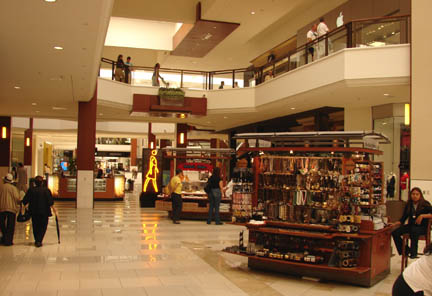
Julian Opie (Excellent website)
Opie's work is appropriate in the pedestrian zone on the mall's floor. But the work is much better in video. The contrast between the stylized, slinky, fluid movement of the LED woman and real walkers in the mall become dramatic in video and was unnoticed in the actual space. The video flattens the movement of people into the same realm as the LED woman. In real time, the people are too 3-D.
Rainbow Valley by Friends with You
Unfortunately, Friends with You created the children's play area called Rainbow Valley. I must admit that I thought the smiling snow covered mountaintops were mediocre commercial constructions. I did not think it was by talented artists until I discovered it via the Internet. (In 2002, the Mall PR praised the new artwork, but today the work is not on the Mall artwork's brochure).
My ignorance shows two things. One: I am out of it. Another proof of the pre-conceptions and limitations of the second wave public art club. (First: 1970s & 80s. Second: 80s and 90s. Third: Today.) The second wave is not even looking for the new. Two: Sometimes utilizing the language of something in the correct space causes it to disappear. The simplistic imagery of "Friends with You" fails to spark adult thought when in a kid's space. The same thing can happen with artists making architectural elements. This is danger for the public art curator.
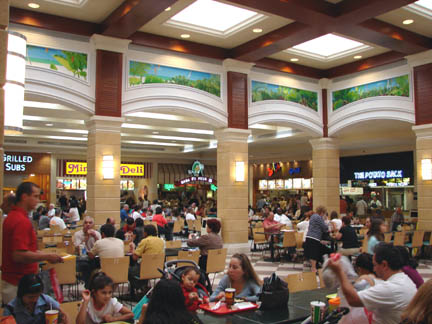
Traditional Mall Public Art in Aventura Food Court
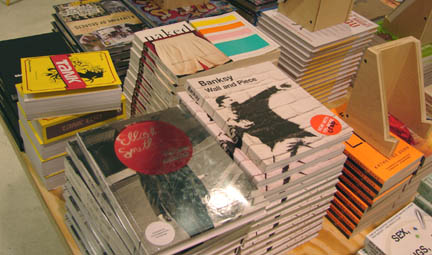
Banksy book for sale with other street artist books at Urban Outfitters.
As my time in shopping malls is infrequent, I discovered Banksy at Urban Outfitters along with other Street Art and Graffiti books. More signals of crossover between the creative industries of fashion, graphics and public art. But it is not the official art, but the unofficial. How can capture the spirit without killing the spirit as happened in the East Village by the 1990s?
I just liked this store.
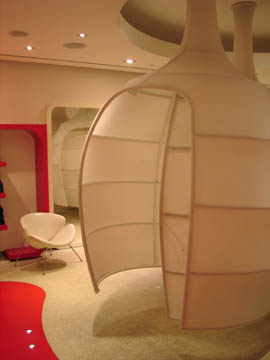
Very nice changing rooms at Miss Sixty. (Great hotel project with 30 rooms by 30 artists in Italy. The Miss Sixty Hotel. )
Click on More for More Works by Wiener, Opie and Friends with You.
Blogroll
Aesthetic Grounds YouTube Site
Selected Videos on Public Art and Public Space
Best of Public Art Websites
1. Muncipal Website: Indianapolis, USA
2. Administration and Case Studies: Public Art Online, UK
3. Photos of USA Projects: Public Art Network, USA
4. Policy for Art in Buildings: Queensland, Australia
5. Sample Contracts, Call to Artists and Other Documents: PAN, USA
6. Sample MP3 Walking Tours: Lower Manhattan Cultural Council, USA
7. Socio-Political Critique through Public Art: Transform, Europe
8. Artist: Pete Codling, UK
9. Artist Registry: 4Culture, USA
10. Community and Public Art: Community Arts
11. Urban Inventions: Wooster Collective
12. Publishing: Black Dog
Best of Public Space Websites
1. Essays: Jane Holtz Kay
2. Functional Criticism: Project for Public Spaces
3. USA Case Studies: Bruner Foundation
4. Lots of Ideas from DC: Richard Layman
Best of Architecture Websites
1. Essays: Hugh Pearman, UK
2. Selected Architecture Images: Eyecandy
3. Essays: James Russell, USA
AJ Ads
AJ Blogs
AJBlogCentral | rssculture
Terry Teachout on the arts in New York City
Andrew Taylor on the business of arts & culture
rock culture approximately
Laura Collins-Hughes on arts, culture and coverage
Richard Kessler on arts education
Douglas McLennan's blog
Dalouge Smith advocates for the Arts
Art from the American Outback
For immediate release: the arts are marketable
No genre is the new genre
David Jays on theatre and dance
Paul Levy measures the Angles
Judith H. Dobrzynski on Culture
John Rockwell on the arts
Jan Herman - arts, media & culture with 'tude
dance
Apollinaire Scherr talks about dance
Tobi Tobias on dance et al...
jazz
Howard Mandel's freelance Urban Improvisation
Focus on New Orleans. Jazz and Other Sounds
Doug Ramsey on Jazz and other matters...
media
Jeff Weinstein's Cultural Mixology
Martha Bayles on Film...
classical music
Fresh ideas on building arts communities
Greg Sandow performs a book-in-progress
Exploring Orchestras w/ Henry Fogel
Harvey Sachs on music, and various digressions
Bruce Brubaker on all things Piano
Kyle Gann on music after the fact
Greg Sandow on the future of Classical Music
Norman Lebrecht on Shifting Sound Worlds
publishing
Jerome Weeks on Books
Scott McLemee on books, ideas & trash-culture ephemera
theatre
Wendy Rosenfield: covering drama, onstage and off
Chloe Veltman on how culture will save the world
visual
Public Art, Public Space
Regina Hackett takes her Art To Go
John Perreault's art diary
Lee Rosenbaum's Cultural Commentary
Tyler Green's modern & contemporary art blog
